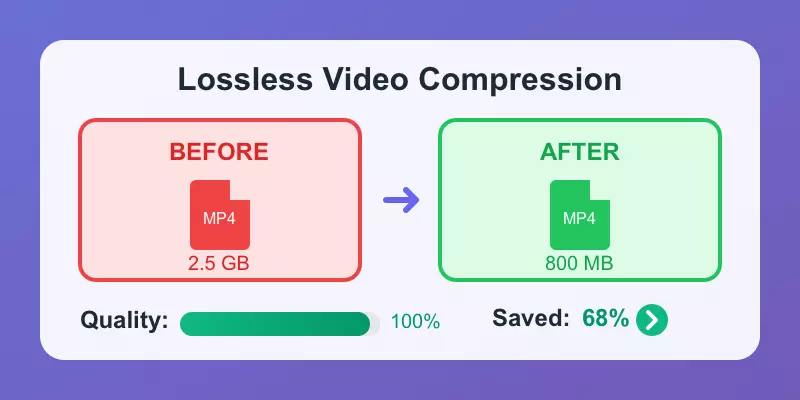Video format conversion is an essential skill in today's digital world. Whether you're preparing videos for different devices, platforms, or storage requirements, understanding how to convert between formats can save you time and ensure optimal playback quality.
Understanding Video Formats
A video format is essentially a container that holds video, audio, and metadata information. Think of it as a digital wrapper that packages all the components of your video file together.
Key Components of Video Files
- Video Codec: Compresses and decompresses video data (e.g., H.264, H.265)
- Audio Codec: Handles audio compression (e.g., AAC, MP3)
- Container Format: The file format that wraps everything together (e.g., MP4, AVI)
- Metadata: Information about the video like title, duration, and creation date
Understanding these components is crucial because different formats support different codecs and features, which directly impacts compatibility, file size, and quality.
Popular Video Formats
MP4 - Universal Standard
Best for: General use, web streaming, mobile devices
- Universal compatibility
- Good compression
- Supports multiple codecs
- Limited editing capabilities
AVI - Legacy Format
Best for: Windows systems, older software
- High quality
- Wide codec support
- Large file sizes
- Limited mobile support
MOV - Apple's Choice
Best for: Mac systems, professional editing
- High quality
- Excellent for editing
- Large files
- Limited compatibility
MKV - Advanced Container
Best for: High-quality video, multiple audio tracks
- Supports many codecs
- Multiple subtitles
- Limited device support
- Complex structure
| Format | Compatibility | File Size | Quality | Best Use Case |
|---|---|---|---|---|
| MP4 | Web, Mobile | |||
| AVI | Windows, Archive | |||
| MOV | Mac, Editing | |||
| MKV | Media Centers |
Choosing the Right Format
Selecting the appropriate video format depends on several factors. Here's a decision framework to help you choose:
Web Streaming
Recommended: MP4 (H.264/H.265)
- Best balance of quality and compatibility
- Supported by all major browsers
- Optimized for online platforms
- Fast loading and streaming
Mobile Devices
Recommended: MP4 (H.264)
- Universal mobile support
- Efficient compression
- Battery-friendly playback
- Hardware acceleration
Video Editing
Recommended: MOV or MKV
- Higher quality preservation
- Better editing software support
- Multiple track support
- Professional features
TV & Media Players
Recommended: MP4 or MKV
- Wide device compatibility
- Feature support (subtitles, audio tracks)
- Good quality-to-size ratio
- Smooth playback
Video Conversion Methods
There are several ways to convert video formats, each with its own advantages:
Desktop Software
Best for: High-quality conversions, batch processing
Advantages:
- Full control over settings
- No file size limits
- Offline processing
- Advanced features
Disadvantages:
- Requires installation
- Learning curve
- May cost money
Online Converters
Best for: Quick conversions, occasional use
Advantages:
- No installation needed
- Easy to use
- Often free
- Cross-platform
Disadvantages:
- File size limits
- Privacy concerns
- Internet required
Mobile Apps
Best for: On-the-go conversions, simple tasks
Advantages:
- Convenient
- Touch interface
- Direct sharing
- Camera integration
Disadvantages:
- Limited processing power
- Basic features
- Battery drain
Step-by-Step Conversion Guide
Here's a detailed walkthrough using desktop video converter software:
Choose Your Conversion Software
Select a reliable video converter like Siovue Video Converter, HandBrake, or FFmpeg. Consider factors like supported formats, ease of use, and advanced features.
Pro Tip
Look for software that supports hardware acceleration for faster conversions.
Import Your Video File
Launch the software and import your source video. Most converters support drag-and-drop or have an "Add File" button.
- Check the source file information (resolution, codec, bitrate)
- Ensure the file isn't corrupted
- Note the original file size for comparison
Select Output Format
Choose your desired output format based on your intended use case. Consider:
- Compatibility: Will it play on your target devices?
- Quality: Do you need lossless or compressed output?
- File Size: Are there storage or bandwidth constraints?
Configure Settings
Adjust conversion parameters for optimal results:
Video Settings
- Resolution: Match source or downscale
- Bitrate: Higher = better quality
- Frame Rate: Keep original (24/30/60 fps)
- Codec: H.264 for compatibility
Audio Settings
- Codec: AAC for most uses
- Bitrate: 128-320 kbps
- Sample Rate: 44.1 kHz or 48 kHz
- Channels: Stereo or surround
Choose Output Location
Select where to save your converted file:
- Use a dedicated folder for converted videos
- Ensure sufficient storage space
- Consider using descriptive filenames
Start Conversion
Begin the conversion process and monitor progress:
- Check estimated completion time
- Monitor CPU/GPU usage
- Avoid using resource-intensive applications during conversion
Important
Don't interrupt the conversion process as it may corrupt the output file.
Verify Output Quality
After conversion, always check the result:
- Play the entire video to check for issues
- Compare file sizes (original vs. converted)
- Test on target devices/platforms
- Check audio sync and quality
Best Practices and Tips
Quality Preservation
- Always keep original files as backups
- Avoid multiple conversions (generation loss)
- Use lossless formats for intermediate editing
- Test different quality settings
Performance Optimization
- Enable hardware acceleration when available
- Close unnecessary applications during conversion
- Use batch processing for multiple files
- Consider overnight processing for large files
Settings Optimization
- Match output resolution to intended display
- Use variable bitrate (VBR) for better quality
- Keep aspect ratio to avoid distortion
- Consider two-pass encoding for best quality
File Management
- Use consistent naming conventions
- Organize files by format or purpose
- Keep metadata and subtitle files together
- Document conversion settings for reference
Common Issues and Solutions
Audio Out of Sync
Solution: Check frame rate settings and ensure audio sample rate matches the source.
Poor Video Quality
Solution: Increase bitrate, check resolution settings, or try a different codec.
Ready to Start Converting?
Siovue Video Converter makes it easy to convert your videos between different formats with professional quality and user-friendly interface.

